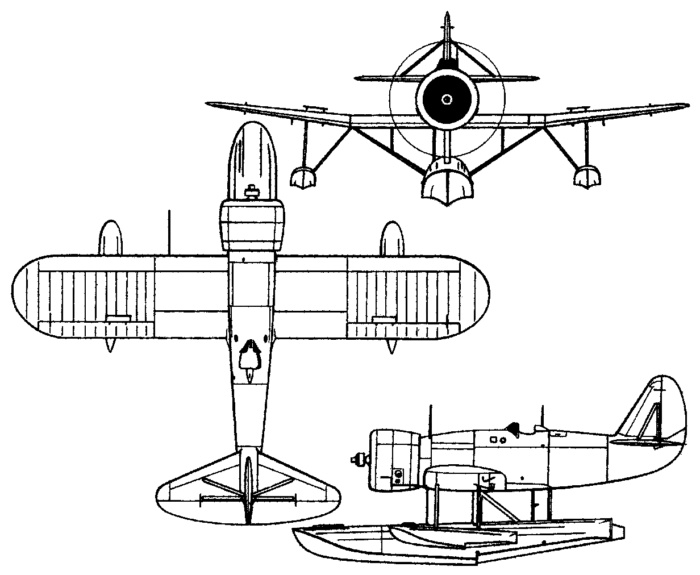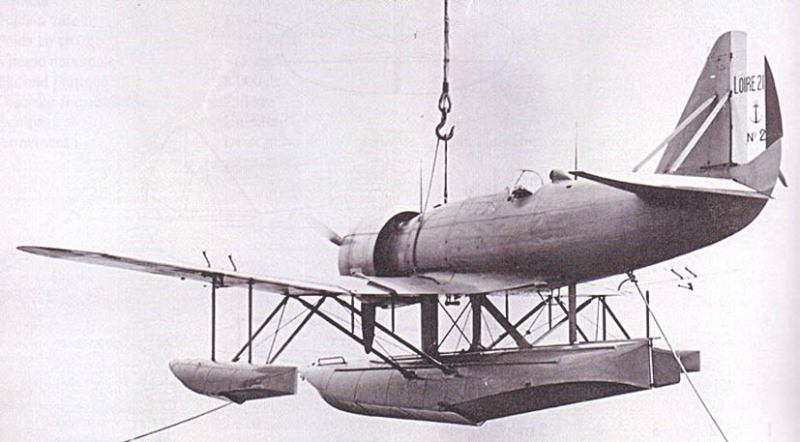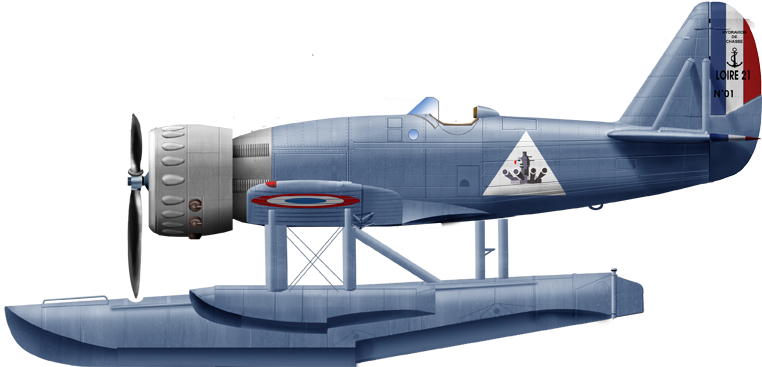The French Naval Fighter
A forgotten model, this French naval aircraft was the first dedicated naval fighter, also usable for reconnaissance and primarily intended to serve on the Commandant Teste. The Loire 210 was a French single-seat catapult-launched fighter seaplane designed and built by Loire Aviation for the French Navy. With only 19 built it entered service in the summer of 1939, most being lost due to wing structural weakness and the rest grounded.
The Loire 210 was designed to meet a 1933 French Navy requirement for a single-seat catapult-launched fighter seaplane. The prototype first flew at Saint Nazaire on 21 March 1935. The fuselage came from the earlier Loire 46 fitted with a new low-wing which was foldable for shipboard stowage. It had a large central float and two underwing auxiliary floats and was powered by a single nose-mounted Hispano-Suiza 9Vbs radial engine.
Context
French Historical Context and genesis
France between the two wars needed to keep its colonies linked at all times in order to survive. There had been a constant development and rejuvenation of the fleet almost from scratch, centered around six elderly dreadnoughts and two rather fast and modern battlecruisers. At the end of the twenties, to that lot, 2 aircraft “carriers” entered the list, with the Béarn and Commandant Teste, the latter dedicated to seaplanes. France could still, at most, build some 60,000 tons of aircraft carriers each not over 8,000 tons of standard tonnage.
Part of the staff still resisted the idea, but a concession at least was to have catapults installed on capital ships and cruisers, for two reasons, the location of the enemy, and its treatment by artillery through airborne spotting, and ASW warfare, with bombs and depht charges.
The notion of controlling the sky above the fleet still met a lot of scepticism in the high command, which ignored Mitchell’s tests in the US to overcome the same scepticism, and this traduced by two shotcomings in the “Royale” in 1939: No radar, despite the technology was already there in France, and lack of efficient anti-aircraft defense. At this game, the French fare no better than most navies, and the wakeup call was brutal: The French naval command realized their mistake when reported the Ju 87 Stuka attacks, first in Norway, and later at Dunkirk.
Until 1939, only the Imperial Japanese Navy (notably because of the influence of Yamamoto) gave consideration to the Naval Air force and make it an unsurpassed instrument in 1941.
For the Marine Nationale, all the remarkably fast and seaworthy cruisers and destroyers built were only turned against surface threats and AA defense (in French “DCA” or “Defense Contre Avions”) was only made ready to deal with close and slow-moving targets with 37 mm guns, the most common caliber on the latest ships, with a ceiling at best to 5,000 m znd in reality closer to 1,500 m. A dive bomber started to make its resource well above this. The rest comprised 25 mm Hotckiss guns, and 13.2, still Hotchkiss, heavy machine guns. Both were operated by hand and with 300 kph biplanes in mind. Some started to realize this inadequacy (as well as in many other fields) and real effort were made from 1935. A model many times faster and with longer range was worked on, but as for so many other ordnances, they still were not enough in May 1940. The very notion of a massive air attack was still far from decision-makers, which, like the ones at the head of the army were stuck in WWI. But the lack of effective AA did not prevented some to propose an alternative: A naval fighter.
The Marine National looks at a first naval fighter
So, as said above, some in the Navy though that a way to circumvent the lack of a good AA weapon, a process that could take years, it was far easier to contact a manufacturer to put a fighter on floats. This was also driven by the rivalry with Italy after the readjustments of the Washington Treeaty and the new naval context in the Mediterraean. Both the young fascist state and the old Republic looked at ways to consolidate and protect their colonial Empire. Some in aviation circles looked with interest as developments in naval fighters on the other side of the Alps.
There was so a revival of the idea of a catapultable fighter seaplane in the navy, following a note from Commander Lartigue (and future admiral) dated 1931.
The Bernard H52 C1 (1933)

Bernard H110 (pinterest)
The aircraft company Bernard at the time, based on its own ideas and without order, worked on a fighter seaplane prototype, the H52 C1. It was relatively modern for the time,
all-metal cantilever monoplane, to better resist rough conditions at sea, and was powered by a Gnome & Rhône 9K, 500 hp. 9.30 m long for 1,460 kg empty, 1,890 kg on takeoff with a 11.30 m span and 18.20 m² surface, a leading edge slat over its entire span. It was not going to break records or run for the Schneider cup with 330 km/h at 4,000 m (range 600 km, climb rate 4,000m in 9 minutes) but at least was an interesting endeavour.
At the same time the Morane-Saulnier 225 was the Béarn own naval fighter, it had the same engine, but without the bulky floats. Both were armed the same way, adequate for the time, two Darne 1933 7.5 mm LMGs. The Bernard 52 flew well but no program was done and no order followed. The concept as still ignored by the top brass.
Lartique’s note however, reinforced by this first model, eventually after two years started to make its way into a program.
1933 specifications for a floatplane fighter
There was a reunion, after which specification laid down specified that this naval fighter was to have a maximum take-off weight of no more than 2,000 kg and it had to be powered by a Hispano-Suiza 9V 700 hp engine shared by the Dewoitine 332, 333 and even the 338 trimotor, considered very reliable, a plus at sea.
The structure had to be however fabric-covered which conpletely contradicted the performance requirements.
In the end, this new catapultable fighter seaplane was to reach 300 km/h at 3,500 m and reach this altitude in 12 minutes. These were very low requirements, which again, show the total misunderstanding of the Air Combat needs. The Nieuport 42 fighter (1924) already made 5,000 m in less than 13 minutes, without compressor or variable-pitch propeller, showing the state of affairs more than a decade later. Also in 1932 top speeds went to 380 km/h routinely for land-based models. To deepens the case, the same speed was asked for the Latécoère 298 program, a torpedo bomber, the same year.
The choice of a Hispano-Suiza 9V, for a fighter plane, with a diameter of just 1.45 m degraded performance on a single engine. Thus, based on a so little-inspired specifications set, it is surprising that competitors even bothered to answer.
Competing designs are evaluated
Dewoitine presented the HD 502 (a navalized D 500 on floats) with an Hispano 12X, which was eliminated from entry due to this engine choice. Dewoitine still, made racing seaplanes for the Schneider Cup. Something the naval staff feigned to ignore. The company had the potential to be the French Supermarine.
The Bernard 110 was also proposed, a development of the previous 52, but the company soon retired, bankrupt.
Potez also knocked at the door with the Potez 453, but its design was marred by poor seakeeping on takeoff handling.
Romano also participated with its model Romano 90 float-biplane, which proved thee fastest on paper at 352 km/h based on its radial engine or 420 kph with the Hispano Suiza 12Y, while being very agile. It was eliminated due to poor seakeeping again. The company however derived from it a Romano 83 and a Romano 92 land fighters which saw action during the Spanish Civil War.
Surprisingly, probably the best fighter seaplane at the time was not even proposed by its manufacturer as it did not answer the specifications (and in time !). This was the Nieuport-Delage 123, flying by early 1934 and seeing 12 built for Peru. The Peruvians bought in addition six conversion kits later refurbished with 780 hp Petrel engines and capable of 330 km/h.
Loire emerged at the winner
The only one which seemed to “take the cake” at the end of this process was Loire. The company was known by the Navy, and its go-to seaplane maker up to that point. The Marine Nationale already had the LGL 800 series (by association with Gourdou lesseure), which was the standard catapulted model of the Marine Nationale since 1930.
Loire proposed the model 210, which seemed promisjng on paper and had elready the Marine’s trust. The prototype was approved in the first round, a prototype was financed, which made its first flight in the spring of 1935. It was tested without incident. Test pilot reported it was easy to manouver. It was also sturdy enough to be catapulted, prepared to taking off in 9 seconds (The Navy requested 15) and after presuading the commission that an all-metal structure was preferrable, it showed good seakeeping as well.
This was in large part due to the unusual choice of a single main-float, degrading speed but helping marine performances. This was the choice retained by IJN naval fighters by the way. Next, the prototype went through official tests, and went through all classic aerobatics. Test pilot again, found it no heavier than land fighters. Official tests ended by the fall of 1935 with an elogious report, and the top speed of 304 km/h at 3,500 m bagged as well.
The company will manage to improve the model during production further, and this figure went to 315 km/h in part due to a more aerodynamic cowling, and it was rated for a max ceiling of 8,000 m, well within the range of most bombers at the time.
A wasted opportunity
In the end, the Loire 210 was quite comparable to the Italian IMAM Ro 44 used from 1943. The Navy though, only had a limited need for these numerically, and only vague ideas on how to use it. Based on minimal provisions in squadron and replacements, only 20 were ordered, 19 just delivered by Loire, by late 1936. In between aviation technology leaped forward, and Loire worked on improving its model, trying to convince the Navy to accept the upgrade (seen later). Alas, this was refused.
Not only that, but the Navy ordered the model unofficially, precluded any manufacturing. It was made official and signed only by May 12, 1937, six months beyond schedule, and thus when delivered in 1938 (based on a 1933 order !). As a result by that time, the Loire 210 was already obsolete, but it was still better than nothing.
Two were lost during tests, and apparently the navy lacked imagination on how to used these and even further procrastinated about their effective deployment.
The Navy by the time should already had looked for a successor and used the 210 to experiment various tactics, helping to define criteria for choosing a successor, but it never happened (see later). The Loire 210 became the one and only serial floatplane fighter of France, and by extension, of the allies at large in WW2.
Design of the Loire 210

General design
The Loire 21 design was straightforward for this category. The fuselage was well balanced but with a cockpit pushed to the rear, a long nose following the massive cowling of its engine, but also straight wings with a light dihedral, more comparable to biplane wings than monoplanes. The prototype Loire 210.01 was unique for its use of a large central float completed by two other smaller ones under wings.
The fuselage was inspired by the Loire 46 ground-based fighter in its general outlines, with a structure made up of welded steel tubes covered with light Duralumin alloy panels, except for the ends of the wings, covered with treated canvas, as requested by the naval staff.
The open cockpit open placed well behind the wings did not ensure a good visibility when landing or taxiing, and was given a front windshield and a rear headrest. The central float was quite long, protruding about 2 meters from the front of the fuselage. Wings are cantilever (low position), are solidarized to the fuselage and the float by an array of V-type struts. The wings are straight with rounded ends, whereras outer panels have a slight positive dihedral. The impont innovation is that these could fold backwards to reduce bulk, facilitate stowage onboard. The tail is of the conventional type but rather large to compensate for the inertia in flight caused by the large central float.
Powerplant
The engine retained was the The Hispano-Suiza 9Vbs, 9-cylinder radial engine rated for 720hp, and up to 980 hp whe upgraded and pushed at max power. It was protected by a cowling, redesigned and fitted with bosses to fir the cylinder heads. It was driving a three-bladed metal propeller which was so large the large single float below had an indentation to to avoid contact.
Maximum endurance was 3 hours at 195 km/h (585 km) and 2 hours at 250 km/h (500 km).
However, even after the first flight, knowing what were they making, the company soon tested new engine configurations to boost the performances. Loire-Nieuport soon performed its own tests with the Gnome et Rhône K14, offering a 27% better torque. This led to a prototype named Loire 211 which reached 330 km/h. The company also worked on the question of a reduction gear and tested the Gnome-Rhône (GR) 14N for an expected 350 km/h. They also proposed to fit the Gnome-Rhône 14 “Mars” rated for 700 Hp or in alternative an inline-conversion to the Hispano-Suiza 14 Ha offering the same output in 1936, expected to go past 360 km/h with a much better range and overall performances across the board.
Armament
The armament comprised four Darne 7.5 mm LMGs, on par with the coming the Bloch 151, one of the main French fighters of 1939. The prtotype however was given only a pair of Darne Mle 1933 7.5 mm machine guns. The whole machine lacked power to lift off any more offensive payload. No provision was made to carry bombs.
⚙ Loire 210 specifications |
|
| Gross Weight | 2,100 kg (4,629 lb) |
| Lenght | 9.51 m (31 ft 2.75 in) |
| Wingspan | 11.79 m (38 ft 8.25 in) |
| Height | 3.80 m (12 ft 5.25 in) |
| Wing Area | 20.3 m2 (218.5 sq ft) |
| Engine | Hispano-Suiza 9Vbs radial piston engine , 537 kW (720 hp) |
| Top Speed | 299 km/h (186 mph, 162 kn) |
| Cruise Speed | 199.5 km/h (124 mph, 108 kn) |
| Range | 750 km (466 mi, 405 nmi) |
| Climb rate | 9.4 m/s (1,897.8 ft/min) |
| Ceiling | 8,000 m (26,250 ft) |
| Armament | 4 x 7.5 mm (0.295 in) Darne machine guns (wing-mounted) |
| Crew | 1 Pilot |
Variants & Operational History
Loire 210.01: First prototype
Loire 210: Single-seat fighter seaplane, 18 serial models
Loire 211: Prototype with a more powerful Gnome-Rhône 14K engine, never adopted.
French Navy: Escadrille HC.1, Escadrille HC.2
The prototype Loire 210.01 was brought to Saint-Nazaire (Atlantic) to carry out its first flight tests within the company from March 21, 1935. Next it was sent to the Maritime Aviation based in Fréjus-Saint-Raphaël (Mediterranean) for its official tests from June 1936, comparative evaluation, declared winner, and 20 ordered on March 19, 1937. The Production model saw the addition of four machine guns in the wings, and first flew on November 18, 1938.
The aircraft entered service with the French Navy in August 1939. The Loire 210 entered service in HC.1 and HC.2 squadrons. Within three months, five were lost due to structural failure of the wing. All the remaining ones were grounded and withdrawn from use. The investigation shown structural problems with the wings. The manufacturer’s estimation of the strenghening work was judged too costly, and the French Navy decided to withdraw the model and and disband the units. This put an end to the Floaplane fighter experipent in France.
These 20 seaplanes were to be used from catapults, one per cruiser or capital ship each (18 ships total), in complement of the observation models. A full squadron was to be provided to Commandant Teste.
They were to be distributed evenly between naval formations, but only in Indochina and Atlantic, not the Mediterranean. For recovery, the French applied the German-developed idea of “notched carpet” (8 m wide, 12 m long, sliding down towards the wake of the carrier ship and the pilot when landed at sea, bled speed voluntarily by zigzagging and aiming for the center of this “ramp” to had the floats hooked, and the ramp brought aboard. The La Galissonière class cruisers and their square stern were tailored to operate these, but they never were equipped with the Loire 210, only the Loire 130.
However even if deployed, the Loire 210 was already doomed by technological progress in 1939. Nevertheless, it was the only one able to spot and destroy Axis floatplanes and naval recce models. The Focke-Wulf 200 was way faster at 360 km/h in top speed, the Loire 210 would have stood no chance to catch it in some circumstances (if spotted too late for example). However for cruising it was well below 260 kph and had a lot of inertia and was certainly less agile. Even with four puny MGs, and despite a generous array of MG.34, the FW.200 was easy meat for the 210.
But this is prospective. The reality is that the Navy’s obstination for a massive engine and canvas-wrapped structure, and then excessive delays, doomed the whole program. Even loire itself, probably discouraged by that attitude, did not persisted in the concept. The Loire 210 fighter seaplane was withdrawn from service after three accidents due to structural issues, excessive vibrations, and the French fleet operated from September 1939 to the armistice of June 1940 without air cover and weak, inadequate AA. What happened in Norway demonstrated the case in ample terms, and Admiral Lartigue, the one that started the idea, renounced it by the end of November 1939. All trained pilots from Loire 210 were sent to land fighters and dive bombers thrown into the hopeless furnace of May 1940.
Meanwhile instead of perfecting the skills of its air group (neglected for years), used Béarn for taxxingr trucks and aircraft from the US via Canada -neutrality obliges- insisted on completing the Richelieu and Jean-Bart instead of focusing on the promising new aircraft carriers of the Joffre class and even ordered, far too late, and eventually realizing the wasted potential, ordered the Dewoitine HD 780 floatplane fighter, based on the excellent land model, far too late. None saw service, the sole propotype was abandoned unflown and scrapped.

Read More

Books
LES HYDRAVIONS A FLOTTEURS 1ère partie – Les Ailes Françaises Gérard BOUSQUET
Links
https://aviadrix.blogspot.com/2013/06/lhydravion-de-chasse-loire-210-ou.html
https://clausuchronia.wordpress.com/tag/loire-210/
Loire 210 floatplane prototype
byu/JoukovDefiant inWeirdWings
https://en.wikipedia.org/wiki/Loire_210
https://fr.wikipedia.org/wiki/Loire_210
http://fighters.forumactif.com/t87225-concours-aeronavale-loire-210-dujin-1-72
https://www.aviafrance.com/loire-210-aviation-france-3934.htm
https://aviationsmilitaires.net/v3/kb/aircraft/show/18517/loire-210
Model Kits
https://www.super-hobby.fr/products/Loire-210-Prototype.html#gallery_start
http://www.kitreview.com/reviews/loire210reviewbg_1.htm
Gallery

Illustration by the author of the Loire 210 Number one (prototype), in service on Dunkerque, 1938

Prototype in flight, 1935 (cc)

One of the serial model in 1939 (pinterest)

Catapult launch (FLICKR)



Loire 210 hoisted aboard an unidentfified ships by crane (pinterest, destinationsjourney.com)

 Latest Facebook Entry -
Latest Facebook Entry -  X(Tweeter) Naval Encyclopedia's deck archive
X(Tweeter) Naval Encyclopedia's deck archive Instagram (@navalencyc)
Instagram (@navalencyc)





 French Navy
French Navy Royal Navy
Royal Navy Russian Navy
Russian Navy Armada Espanola
Armada Espanola Austrian Navy
Austrian Navy K.u.K. Kriegsmarine
K.u.K. Kriegsmarine Dansk Marine
Dansk Marine Nautiko Hellenon
Nautiko Hellenon Koninklije Marine 1870
Koninklije Marine 1870 Marinha do Brasil
Marinha do Brasil Osmanlı Donanması
Osmanlı Donanması Marina Do Peru
Marina Do Peru Marinha do Portugal
Marinha do Portugal Regia Marina 1870
Regia Marina 1870 Nihhon Kaigun 1870
Nihhon Kaigun 1870 Preußische Marine 1870
Preußische Marine 1870 Russkiy Flot 1870
Russkiy Flot 1870 Svenska marinen
Svenska marinen Søværnet
Søværnet Union Navy
Union Navy Confederate Navy
Confederate Navy Armada de Argentina
Armada de Argentina Imperial Chinese Navy
Imperial Chinese Navy Marinha do Portugal
Marinha do Portugal Mexico
Mexico Kaiserliche Marine
Kaiserliche Marine 1898 US Navy
1898 US Navy Sovietskiy Flot
Sovietskiy Flot Royal Canadian Navy
Royal Canadian Navy Royal Australian Navy
Royal Australian Navy RNZN Fleet
RNZN Fleet Chinese Navy 1937
Chinese Navy 1937 Kriegsmarine
Kriegsmarine Chilean Navy
Chilean Navy Danish Navy
Danish Navy Finnish Navy
Finnish Navy Hellenic Navy
Hellenic Navy Polish Navy
Polish Navy Romanian Navy
Romanian Navy Turkish Navy
Turkish Navy Royal Yugoslav Navy
Royal Yugoslav Navy Royal Thai Navy
Royal Thai Navy Minor Navies
Minor Navies Albania
Albania Austria
Austria Belgium
Belgium Columbia
Columbia Costa Rica
Costa Rica Cuba
Cuba Czechoslovakia
Czechoslovakia Dominican Republic
Dominican Republic Haiti
Haiti Hungary
Hungary Honduras
Honduras Estonia
Estonia Iceland
Iceland Eire
Eire Equador
Equador Iran
Iran Iraq
Iraq Latvia
Latvia Liberia
Liberia Lithuania
Lithuania Mandchukuo
Mandchukuo Morocco
Morocco Nicaragua
Nicaragua Persia
Persia San Salvador
San Salvador Sarawak
Sarawak Uruguay
Uruguay Venezuela
Venezuela Zanzibar
Zanzibar Warsaw Pact Navies
Warsaw Pact Navies Bulgaria
Bulgaria Hungary
Hungary

 Bundesmarine
Bundesmarine Dutch Navy
Dutch Navy Hellenic Navy
Hellenic Navy Marina Militare
Marina Militare Yugoslav Navy
Yugoslav Navy Chinese Navy
Chinese Navy Indian Navy
Indian Navy Indonesian Navy
Indonesian Navy JMSDF
JMSDF North Korean Navy
North Korean Navy Pakistani Navy
Pakistani Navy Philippines Navy
Philippines Navy ROKN
ROKN Rep. of Singapore Navy
Rep. of Singapore Navy Taiwanese Navy
Taiwanese Navy IDF Navy
IDF Navy Saudi Navy
Saudi Navy Royal New Zealand Navy
Royal New Zealand Navy Egyptian Navy
Egyptian Navy South African Navy
South African Navy






























 Ukrainian Navy
Ukrainian Navy dbodesign
dbodesign